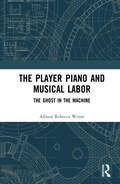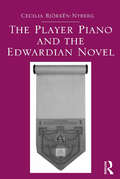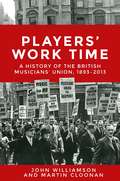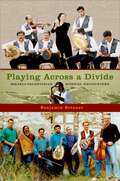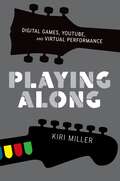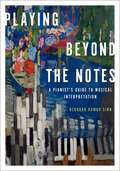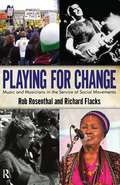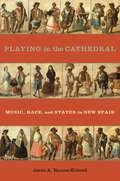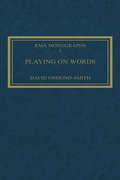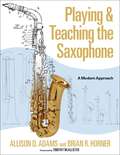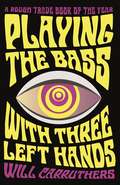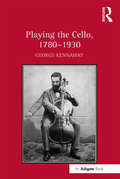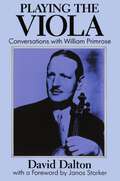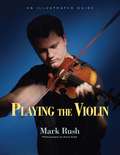- Table View
- List View
The Player Piano and Musical Labor: The Ghost in the Machine
by Allison Rebecca WenteBy the early 20th century the machine aesthetic was a well-established and dominant interest that fundamentally transformed musical performance and listening practices. While numerous scholars have examined this aesthetic in art and literature, musical compositions representing industrialized labor practices and the role of the machine in music remain largely unexplored. Moreover, in recounting the history of machines in musical recording and reproduction, scholars often tend to emphasize the phonograph, rather than player piano, despite the latter’s prominence within the newly established musical marketplace. Machines and their music influenced multiple areas of early 20th-century musical culture, from film scores to popular music and even the concert hall. But the opposite was also true: industrialized labor practices changed the musical marketplace and musical culture as a whole. As consumers accepted mechanical replacements for what previously required an active human laborer, ghostly, mechanical performers labored tirelessly in parlors, businesses, and even concert halls. Although the player piano failed to maintain a stronghold in the recorded music marketplace after 1930, the widespread acceptance of recording technologies as media for storing and enjoying music indicates a much more fundamental societal shift. This book explores that shift, examining the rise and fall of the player piano in early 20th-century society and connecting it to the digital technologies of today.
The Player Piano and Musical Labor: The Ghost in the Machine
by Allison Rebecca WenteBy the early 20th century the machine aesthetic was a well-established and dominant interest that fundamentally transformed musical performance and listening practices. While numerous scholars have examined this aesthetic in art and literature, musical compositions representing industrialized labor practices and the role of the machine in music remain largely unexplored. Moreover, in recounting the history of machines in musical recording and reproduction, scholars often tend to emphasize the phonograph, rather than player piano, despite the latter’s prominence within the newly established musical marketplace. Machines and their music influenced multiple areas of early 20th-century musical culture, from film scores to popular music and even the concert hall. But the opposite was also true: industrialized labor practices changed the musical marketplace and musical culture as a whole. As consumers accepted mechanical replacements for what previously required an active human laborer, ghostly, mechanical performers labored tirelessly in parlors, businesses, and even concert halls. Although the player piano failed to maintain a stronghold in the recorded music marketplace after 1930, the widespread acceptance of recording technologies as media for storing and enjoying music indicates a much more fundamental societal shift. This book explores that shift, examining the rise and fall of the player piano in early 20th-century society and connecting it to the digital technologies of today.
The Player Piano and the Edwardian Novel
by Cecilia Bjorken-NybergIn her study of music-making in the Edwardian novel, Cecilia Björkén-Nyberg argues that the invention and development of the player piano had a significant effect on the perception, performance and appreciation of music during the period. In contrast to existing devices for producing music mechanically such as the phonograph and gramophone, the player piano granted its operator freedom of individual expression by permitting the performer to modify the tempo. Because the traditional piano was the undisputed altar of domestic and highly gendered music-making, Björkén-Nyberg suggests, the potential for intervention by the mechanical piano's operator had a subversive effect on traditional notions about the status of the musical work itself and about the people who were variously defined by their relationship to it. She examines works by Dorothy Richardson, E.M. Forster, Henry Handel Richardson, Max Beerbohm and Compton Mackenzie, among others, contending that Edwardian fiction with music as a subject undermined the prevalent antithesis, expressed in contemporary music literature, between a nineteenth-century conception of music as a means of transcendence and the increasing mechanisation of music as represented by the player piano. Her timely survey of the player piano in the context of Edwardian commercial and technical discourse draws on a rich array of archival materials to shed new light on the historically conditioned activity of music-making in early twentieth-century fiction.
The Player Piano and the Edwardian Novel
by Cecilia Bjorken-NybergIn her study of music-making in the Edwardian novel, Cecilia Björkén-Nyberg argues that the invention and development of the player piano had a significant effect on the perception, performance and appreciation of music during the period. In contrast to existing devices for producing music mechanically such as the phonograph and gramophone, the player piano granted its operator freedom of individual expression by permitting the performer to modify the tempo. Because the traditional piano was the undisputed altar of domestic and highly gendered music-making, Björkén-Nyberg suggests, the potential for intervention by the mechanical piano's operator had a subversive effect on traditional notions about the status of the musical work itself and about the people who were variously defined by their relationship to it. She examines works by Dorothy Richardson, E.M. Forster, Henry Handel Richardson, Max Beerbohm and Compton Mackenzie, among others, contending that Edwardian fiction with music as a subject undermined the prevalent antithesis, expressed in contemporary music literature, between a nineteenth-century conception of music as a means of transcendence and the increasing mechanisation of music as represented by the player piano. Her timely survey of the player piano in the context of Edwardian commercial and technical discourse draws on a rich array of archival materials to shed new light on the historically conditioned activity of music-making in early twentieth-century fiction.
Players' work time: A history of the British Musicians' Union, 1893–2013 (PDF)
by John Williamson Martin CloonanThis is about musicians’ working lives in Britain from the late Victorian era to the present day. Using the Musicians’ Union as a prism through which to explore those lives, the book illuminates the key factors which shape musicians’ working lives including such things as changes in technology, law and the music industries, while also considering matters of nationality, gender and genre. Anyone interested in music and the people who make it will be interested in this history.
Players' work time: A history of the British Musicians' Union, 1893–2013
by John Williamson Martin CloonanThis is about musicians’ working lives in Britain from the late Victorian era to the present day. Using the Musicians’ Union as a prism through which to explore those lives, the book illuminates the key factors which shape musicians’ working lives including such things as changes in technology, law and the music industries, while also considering matters of nationality, gender and genre. Anyone interested in music and the people who make it will be interested in this history.
Playing across a Divide: Israeli-Palestinian Musical Encounters
by Benjamin BrinnerIn the last decade of the twentieth century and on into the twenty-first, Israelis and Palestinians saw the signing of the Oslo Peace Accords, the establishment of the Palestinian Authority, the assassination of Israeli Prime Minister Yitzhak Rabin, and the escalation of suicide bombings and retaliations in the region. During this tumultuous time, numerous collaborations between Israeli and Palestinian musicians coalesced into a significant musical scene informed by these extremes of hope and despair on both national and personal levels. Following the bands Bustan Abraham and Alei Hazayit from their creation and throughout their careers, as well as the collaborative projects of Israeli artist Yair Dalal, Playing Across a Divide demonstrates the possibility of musical alternatives to violent conflict and hatred in an intensely contested, multicultural environment. These artists' music drew from Western, Middle Eastern, Central Asian, and Afro-diasporic musical practices, bridging differences and finding innovative solutions to the problems inherent in combining disparate musical styles and sources. Creating this new music brought to the forefront the musicians' contrasting assumptions about sound production, melody, rhythm, hybridity, ensemble interaction, and improvisation. Author Benjamin Brinner traces the tightly interconnected field of musicians and the people and institutions that supported them as they and their music circulated within the region and along international circuits. Brinner argues that the linking of Jewish and Arab musicians' networks, the creation of new musical means of expression, and the repeated enactment of culturally productive musical alliances provide a unique model for mutually respectful and beneficial coexistence in a chronically disputed land.
Playing across a Divide: Israeli-Palestinian Musical Encounters
by Benjamin BrinnerIn the last decade of the twentieth century and on into the twenty-first, Israelis and Palestinians saw the signing of the Oslo Peace Accords, the establishment of the Palestinian Authority, the assassination of Israeli Prime Minister Yitzhak Rabin, and the escalation of suicide bombings and retaliations in the region. During this tumultuous time, numerous collaborations between Israeli and Palestinian musicians coalesced into a significant musical scene informed by these extremes of hope and despair on both national and personal levels. Following the bands Bustan Abraham and Alei Hazayit from their creation and throughout their careers, as well as the collaborative projects of Israeli artist Yair Dalal, Playing Across a Divide demonstrates the possibility of musical alternatives to violent conflict and hatred in an intensely contested, multicultural environment. These artists' music drew from Western, Middle Eastern, Central Asian, and Afro-diasporic musical practices, bridging differences and finding innovative solutions to the problems inherent in combining disparate musical styles and sources. Creating this new music brought to the forefront the musicians' contrasting assumptions about sound production, melody, rhythm, hybridity, ensemble interaction, and improvisation. Author Benjamin Brinner traces the tightly interconnected field of musicians and the people and institutions that supported them as they and their music circulated within the region and along international circuits. Brinner argues that the linking of Jewish and Arab musicians' networks, the creation of new musical means of expression, and the repeated enactment of culturally productive musical alliances provide a unique model for mutually respectful and beneficial coexistence in a chronically disputed land.
Playing Along: Digital Games, YouTube, and Virtual Performance (Oxford Music / Media)
by Kiri MillerWhy don't Guitar Hero players just pick up real guitars? What happens when millions of people play the role of a young black gang member in Grand Theft Auto: San Andreas? How are YouTube-based music lessons changing the nature of amateur musicianship? This book is about play, performance, and participatory culture in the digital age. Miller shows how video games and social media are bridging virtual and visceral experience, creating dispersed communities who forge meaningful connections by "playing along" with popular culture. Playing Along reveals how digital media are brought to bear in the transmission of embodied knowledge: how a Grand Theft Auto player uses a virtual radio to hear with her avatar's ears; how a Guitar Hero player channels the experience of a live rock performer; and how a beginning guitar student translates a two-dimensional, pre-recorded online music lesson into three-dimensional physical practice and an intimate relationship with a distant teacher. Through a series of engaging ethnographic case studies, Miller demonstrates that our everyday experiences with interactive digital media are gradually transforming our understanding of musicality, creativity, play, and participation.
Playing Along: Digital Games, YouTube, and Virtual Performance (Oxford Music / Media)
by Kiri MillerWhy don't Guitar Hero players just pick up real guitars? What happens when millions of people play the role of a young black gang member in Grand Theft Auto: San Andreas? How are YouTube-based music lessons changing the nature of amateur musicianship? This book is about play, performance, and participatory culture in the digital age. Miller shows how video games and social media are bridging virtual and visceral experience, creating dispersed communities who forge meaningful connections by "playing along" with popular culture. Playing Along reveals how digital media are brought to bear in the transmission of embodied knowledge: how a Grand Theft Auto player uses a virtual radio to hear with her avatar's ears; how a Guitar Hero player channels the experience of a live rock performer; and how a beginning guitar student translates a two-dimensional, pre-recorded online music lesson into three-dimensional physical practice and an intimate relationship with a distant teacher. Through a series of engaging ethnographic case studies, Miller demonstrates that our everyday experiences with interactive digital media are gradually transforming our understanding of musicality, creativity, play, and participation.
Playing Beyond the Notes: A Pianist's Guide to Musical Interpretation
by Deborah Rambo SinnPlaying Beyond the Notes: A Pianist's Guide to Musical Interpretation demystifies the complex concepts of musical interpretation in Western tonal piano music by boiling it down to basic principles in an accessible writing style. Author and veteran piano instructor Deborah Rambo Sinn tackles a different interpretive principle, explaining clearly, for example, how to play effective ornaments and rubatos. As a whole, the book helps pianists understand concrete ways to apply interpretive concepts to their own playing and gives teachers practical ways to teach interpretation to their students. The book is illustrated with over 200 repertoire excerpts and supplemented by a companion website with over 100 audio recordings. Playing Beyond the Notes is essential reading for all performing pianists, independent piano teachers, and piano pedagogy students.
Playing Beyond the Notes: A Pianist's Guide to Musical Interpretation
by Deborah Rambo SinnPlaying Beyond the Notes: A Pianist's Guide to Musical Interpretation demystifies the complex concepts of musical interpretation in Western tonal piano music by boiling it down to basic principles in an accessible writing style. Author and veteran piano instructor Deborah Rambo Sinn tackles a different interpretive principle, explaining clearly, for example, how to play effective ornaments and rubatos. As a whole, the book helps pianists understand concrete ways to apply interpretive concepts to their own playing and gives teachers practical ways to teach interpretation to their students. The book is illustrated with over 200 repertoire excerpts and supplemented by a companion website with over 100 audio recordings. Playing Beyond the Notes is essential reading for all performing pianists, independent piano teachers, and piano pedagogy students.
Playing for Change: Music and Musicians in the Service of Social Movements
by Rob Rosenthal Richard FlacksAlthough music is known to be part of the great social movements that have rocked the world, its specific contribution to political struggle has rarely been closely analyzed. Is it truly the 'lifeblood' of movements, as some have declared, or merely the entertainment between the speeches? Drawing on interviews, case studies and musical and lyrical analysis, Rosenthal and Flacks offer a brilliant analysis and a wide-ranging look at the use of music in movements, in the US and elsewhere, over the past hundred years. From their interviews, the voices of Pete Seeger, Ani DiFranco, Tom Morello, Holly Near, and many others enliven this highly readable book.
Playing in the Cathedral: Music, Race, and Status in New Spain (Currents in Latin American and Iberian Music)
by Jesús A. Ramos-KittrellThroughout Spanish colonial America, limpieza de sangre (literally, "purity of blood") determined an individual's status within the complex system of social hierarchy called casta. Within this socially stratified culture, those individuals at the top were considered to have the highest calidad-an all-encompassing estimation of a person's social status. At the top of the social pyramid were the Peninsulares: Spaniards born in Spain, who controlled most of the positions of power within the colonial governments and institutions. Making up most of the middle-class were criollos, locally born people of Spanish ancestry. During the late seventeenth and early eighteenth centuries, Peninsulare intellectuals asserted their cultural superiority over criollos by claiming that American Spaniards had a generally lower calidad because of their "impure" racial lineage. Still, given their Spanish heritage, criollos were allowed employment at many Spanish institutions in New Spain, including the center of Spanish religious practice in colonial America: Mexico City Cathedral. Indeed, most of the cathedral employees-in particular, musicians-were middle-class criollos. In Playing in the Cathedral, author Jesús Ramos-Kittrell explores how liturgical musicians-choristers and instrumentalists, as well as teachers and directors-at Mexico City Cathedral in the mid-eighteenth century navigated changing discourses about social status and racial purity. He argues that criollos cathedral musicians, influenced by Enlightenment values of self-industry and autonomy, fought against the Peninsulare-dominated, racialized casta system. Drawing on extensive archival research, Ramos-Kittrell shows that these musicians held up their musical training and knowledge, as well as their institutional affiliation with the cathedral, as characteristics that legitimized their calidad and aided their social advancement. The cathedral musicians invoked claims of "decency" and erudition in asserting their social worth, arguing that their performance capabilities and theoretical knowledge of counterpoint bespoke their calidad and status as hombres decentes. Ultimately, Ramos-Kittrell argues that music, as a performative and theoretical activity, was a highly dynamic factor in the cultural and religious life of New Spain, and an active agent in the changing discourses of social status and "Spanishness" in colonial America. Offering unique and fascinating insights into the social, institutional, and artistic spheres in New Spain, this book is a welcome addition to scholars and graduate students with particular interests in Latin American colonial music and cultural history, as well as those interested in the intersections of music and religion.
Playing in the Cathedral: Music, Race, and Status in New Spain (Currents in Latin American and Iberian Music)
by Jesús A. Ramos-KittrellThroughout Spanish colonial America, limpieza de sangre (literally, "purity of blood") determined an individual's status within the complex system of social hierarchy called casta. Within this socially stratified culture, those individuals at the top were considered to have the highest calidad-an all-encompassing estimation of a person's social status. At the top of the social pyramid were the Peninsulares: Spaniards born in Spain, who controlled most of the positions of power within the colonial governments and institutions. Making up most of the middle-class were criollos, locally born people of Spanish ancestry. During the late seventeenth and early eighteenth centuries, Peninsulare intellectuals asserted their cultural superiority over criollos by claiming that American Spaniards had a generally lower calidad because of their "impure" racial lineage. Still, given their Spanish heritage, criollos were allowed employment at many Spanish institutions in New Spain, including the center of Spanish religious practice in colonial America: Mexico City Cathedral. Indeed, most of the cathedral employees-in particular, musicians-were middle-class criollos. In Playing in the Cathedral, author Jesús Ramos-Kittrell explores how liturgical musicians-choristers and instrumentalists, as well as teachers and directors-at Mexico City Cathedral in the mid-eighteenth century navigated changing discourses about social status and racial purity. He argues that criollos cathedral musicians, influenced by Enlightenment values of self-industry and autonomy, fought against the Peninsulare-dominated, racialized casta system. Drawing on extensive archival research, Ramos-Kittrell shows that these musicians held up their musical training and knowledge, as well as their institutional affiliation with the cathedral, as characteristics that legitimized their calidad and aided their social advancement. The cathedral musicians invoked claims of "decency" and erudition in asserting their social worth, arguing that their performance capabilities and theoretical knowledge of counterpoint bespoke their calidad and status as hombres decentes. Ultimately, Ramos-Kittrell argues that music, as a performative and theoretical activity, was a highly dynamic factor in the cultural and religious life of New Spain, and an active agent in the changing discourses of social status and "Spanishness" in colonial America. Offering unique and fascinating insights into the social, institutional, and artistic spheres in New Spain, this book is a welcome addition to scholars and graduate students with particular interests in Latin American colonial music and cultural history, as well as those interested in the intersections of music and religion.
Playing on Words: A Guide to Luciano Berio's Sinfonia (Royal Musical Association Monographs)
by David Osmond-SmithLuciano Berio's Sinfonia (1968) marked a return by the composer to orchestral writing after a gap of six years. This in-depth study demonstrates the central position the work occupies in Berio's output. David Osmond-Smith discusses the way in which Berio used the Bororo myth described in Levi-Strauss's Le cru et le cuit as a framework for Sinfonia. This is one of many influences in the work, which also include Joyce's 'Sirens' chapter from Ulysses, Beckett's The Unnameable and the scherzo from Mahler's 2nd Symphony. The listener who takes refuge in the score of Sinfonia, argues Osmond-Smith, finds there a maze of allusions to things beyond the score. It is some of those allusions that this book seeks to illuminate.
Playing on Words: A Guide to Luciano Berio's Sinfonia (Royal Musical Association Monographs)
by David Osmond-SmithLuciano Berio's Sinfonia (1968) marked a return by the composer to orchestral writing after a gap of six years. This in-depth study demonstrates the central position the work occupies in Berio's output. David Osmond-Smith discusses the way in which Berio used the Bororo myth described in Levi-Strauss's Le cru et le cuit as a framework for Sinfonia. This is one of many influences in the work, which also include Joyce's 'Sirens' chapter from Ulysses, Beckett's The Unnameable and the scherzo from Mahler's 2nd Symphony. The listener who takes refuge in the score of Sinfonia, argues Osmond-Smith, finds there a maze of allusions to things beyond the score. It is some of those allusions that this book seeks to illuminate.
Playing & Teaching the Saxophone: A Modern Approach
by Allison D. Adams Brian R. HornerPlaying & Teaching the Saxophone: A Modern Approach provides a method for teaching the saxophone that is specific enough to use as a textbook in a collegiate saxophone methods class, simple enough for a band director to use in guiding their saxophone sections, clear enough for adult beginners to teach themselves the instrument, and deep enough for professionals to use as a resource in teaching private lessons at any level. The first sections of this book, Getting Started and Learning the Notes, take a student in a collegiate methods class or other adult beginner through the fundamental concepts of playing the saxophone. The In-Depth section then lays out critical concepts that are essential to the further development of any saxophonist. As a contemporary guide for teaching the musicians and music educators of the 21st century, this method addresses the pedagogy of not only the instrument, but of the whole student. It includes a diverse array of musical examples that celebrate communities and cultures around the globe, and a "Wellness for the Young Musician" chapter offers an overview of practices that will help students navigate performance anxiety and avoid injury while playing. Designed to be a lifelong reference for band directors and private instructors, the book includes "Hand-It-Over" sections that can be used as student instructional sheets. These materials, along with video performances and teaching demonstrations, are also available in the book's companion website.
Playing & Teaching the Saxophone: A Modern Approach
by Allison D. Adams Brian R. HornerPlaying & Teaching the Saxophone: A Modern Approach provides a method for teaching the saxophone that is specific enough to use as a textbook in a collegiate saxophone methods class, simple enough for a band director to use in guiding their saxophone sections, clear enough for adult beginners to teach themselves the instrument, and deep enough for professionals to use as a resource in teaching private lessons at any level. The first sections of this book, Getting Started and Learning the Notes, take a student in a collegiate methods class or other adult beginner through the fundamental concepts of playing the saxophone. The In-Depth section then lays out critical concepts that are essential to the further development of any saxophonist. As a contemporary guide for teaching the musicians and music educators of the 21st century, this method addresses the pedagogy of not only the instrument, but of the whole student. It includes a diverse array of musical examples that celebrate communities and cultures around the globe, and a "Wellness for the Young Musician" chapter offers an overview of practices that will help students navigate performance anxiety and avoid injury while playing. Designed to be a lifelong reference for band directors and private instructors, the book includes "Hand-It-Over" sections that can be used as student instructional sheets. These materials, along with video performances and teaching demonstrations, are also available in the book's companion website.
Playing the Bass with Three Left Hands
by Will CarruthersI can confirm that should you ever find yourself on stage playing the bass guitar with tree left hands, it is usually the one in the middle that is the real one. The other two are probably phantoms. Playing the Bass with Three Left Hands tells the story of one of the most influential, revered and ultimately demented British bands of the 1980s, Spacemen 3. In classic rock n roll style they split up on the brink of their major breakthrough. As the decade turned sour and acid house hit the news, Rugby's finest imploded spectacularly, with Jason Pierce (aka Jason Spaceman) and Pete Kember (aka Sonic Boom) going their separate ways. Here, Will Carruthers tells the whole sorry story and the segue into Spirtualised in one of the funniest and most memorable memoirs committed to the page.
Playing the Cello, 1780-1930
by George KennawayThis innovative study of nineteenth-century cellists and cello playing shows how simple concepts of posture, technique and expression changed over time, while acknowledging that many different practices co-existed. By placing an awareness of this diversity at the centre of an historical narrative, George Kennaway has produced a unique cultural history of performance practices. In addition to drawing upon an unusually wide range of source materials - from instructional methods to poetry, novels and film - Kennaway acknowledges the instability and ambiguity of the data that supports historically informed performance. By examining nineteenth-century assumptions about the very nature of the cello itself, he demonstrates new ways of thinking about historical performance today. Kennaway’s treatment of tone quality and projection, and of posture, bow-strokes and fingering, is informed by his practical insights as a professional cellist and teacher. Vibrato and portamento are examined in the context of an increasing divergence between theory and practice, as seen in printed sources and heard in early cello recordings. Kennaway also explores differing nineteenth-century views of the cello’s gendered identity and the relevance of these cultural tropes to contemporary performance. By accepting the diversity and ambiguity of nineteenth-century sources, and by resisting oversimplified solutions, Kennaway has produced a nuanced performing history that will challenge and engage musicologists and performers alike.
Playing the Cello, 1780-1930
by George KennawayThis innovative study of nineteenth-century cellists and cello playing shows how simple concepts of posture, technique and expression changed over time, while acknowledging that many different practices co-existed. By placing an awareness of this diversity at the centre of an historical narrative, George Kennaway has produced a unique cultural history of performance practices. In addition to drawing upon an unusually wide range of source materials - from instructional methods to poetry, novels and film - Kennaway acknowledges the instability and ambiguity of the data that supports historically informed performance. By examining nineteenth-century assumptions about the very nature of the cello itself, he demonstrates new ways of thinking about historical performance today. Kennaway’s treatment of tone quality and projection, and of posture, bow-strokes and fingering, is informed by his practical insights as a professional cellist and teacher. Vibrato and portamento are examined in the context of an increasing divergence between theory and practice, as seen in printed sources and heard in early cello recordings. Kennaway also explores differing nineteenth-century views of the cello’s gendered identity and the relevance of these cultural tropes to contemporary performance. By accepting the diversity and ambiguity of nineteenth-century sources, and by resisting oversimplified solutions, Kennaway has produced a nuanced performing history that will challenge and engage musicologists and performers alike.
Playing the Viola: Conversations with William Primrose
by David Dalton`In all areas of human endeavour, time and again an individual appears who, due to a multitude of personal attributes, elevates his or her field to a hitherto unknown height. Such an individual was William Primrose. His name and the viola are synonymous.' Janos Starker This unique book is the result of a series of conversations with Primrose in the last years before his death in 1982. David Dalton describes how he came to the great artist armed with every question he could think of pertaining to performing on and teaching the viola. The lively dialogue contains a wealth of illuminating advice for the student on the technicalities of playing the viola. It is, however, far more than a technical guide. The two violists discuss the unique position of their instrument - `an instrument without tradition' is Primrose's bald description. They cover the topic of repertoire with fascinating insights into the performance of the great concertos by Bartók and Walton, with which Primrose was so closely associated. Still more invaluable advice emerges from the discussion of Primrose's own experience, on the art of performance, on demeanour on stage, on competitions, on recordings, and on preparing for a career. The book is a tribute to one of the greatest artists of this century.
Playing the Violin
by Mark RushDrawing on twenty years of teaching experience, author Mark Rush systematically builds the fundamentals of violin playing from the ground up. The book focuses on proper setup from how to stand, to holding the violin, to the best way to move the bow. These are fundamental components necessary for success and the earlier these good habits are established the better.
Playing the Violin
by Mark RushDrawing on twenty years of teaching experience, author Mark Rush systematically builds the fundamentals of violin playing from the ground up. The book focuses on proper setup from how to stand, to holding the violin, to the best way to move the bow. These are fundamental components necessary for success and the earlier these good habits are established the better.
